Night on a cattle station
It took us a little while to get ourselves out of Coober Pedy this morning. What with queuing up to buy fresh drinking water, buying a new gas stove, Nina's 10,000 steps and my mandatory cafe visit for a coffee we did not even get to the underground museum and mine until 10:00am. The museum was pretty good and of course depicted the story of opal discovery and the development of mining in this region. Like a lot of pioneer stories the beginning of opal mining at the Coober Pedy location is a tale of determination bordering on crazyness. After the initial discovery two men arrived at the site with 100 gallons of water on a bullock dray and stayed mining until their water ran out. To extend their water they collected all used waste water in a drum and skimmed the "clean" water off the top. When that finally ran out they had to walk 90 miles to a nearby rail head. All this in a region that is recognized as the driest part of Australia, the driest continent on earth.
Today water is plentiful in Coober Pedy and supports a lot of small to medium sized mines as well as a thriving tourist trade. The water is provided by desalinating bore water from the Great Artesian Basin.
The museum also had a good, though small, display on the famous (to Australians at least) Dog Fence, a 5,500 km wire mesh fence that keeps wild dogs (dingoes) to the north of the fence allowing sheep to be raised south of the fence. Apparently the Dog Fence is the longest man made structure on the planet.
In the "garden" outside the museum Nina found a number of Sturt Desert Peas an iconic desert plant and state flower of South Australia.
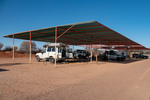
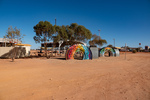
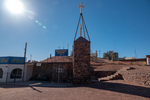
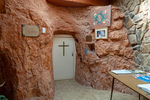
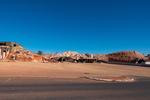
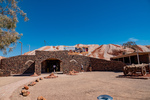
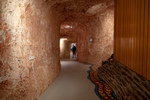
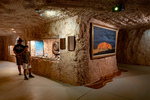
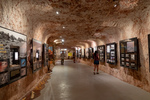
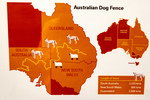
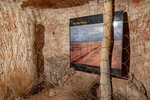
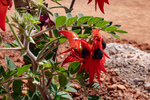
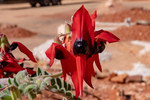
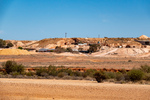
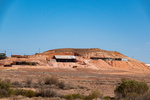
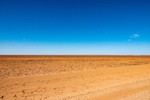
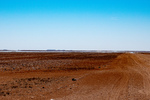
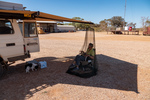
From Coober we headed north east towards Oodnadatta along what is called the Kempe Road. But about 100 km out we detoured to a cattle station named Arckaringa which advertises accommodation and camping for travelers and as a good base to see South Australia's version of the Painted Desert. We thought it would be interesting to spend the night on a cattle station and we could visit the painted desert tomorrow as we continue to Oodnadatta.
We had no trouble finding the station but were a bit surprised to find no one at home. But there were signs telling us to "find a site and self register".
Pretty soon after setting up camp the two station dogs found us and spent the remainder of the day in our company. Interestingly the dogs would periodically scrape a small depression in the soil to find "cooler" ground and then lay in it.
The camp was basic but adequate. Flush toilets and showers in a very Australian building of corrugated iron, a basic camp kitchen but no power.
We spent the afternoon preparing food for the next few days, being entertained by the dogs, and also being entertained by the antics of the local white and pink/grey parrots as they fought for position on the stations two radio towers.
About 8:00 pm someone arrived in a blaze of driving lights and dust. They turned on the generator, the lights and retired to the home stead leaving us to ourselves.
One of the interesting facts I picked up from the numerous signs around the place was that the station was approximately 2700 square kilometers and it is authorised to stock 2100 head of cattle (Overstocking was a major environmental problem during Australias pioneering days and there is now a degree of regulation of stocking levels). I did the conversion on these numbers and it comes out at just a little under 2 cows per square mile.